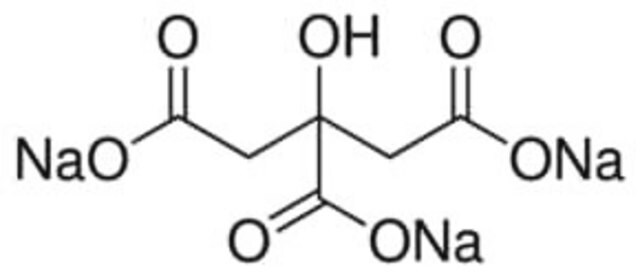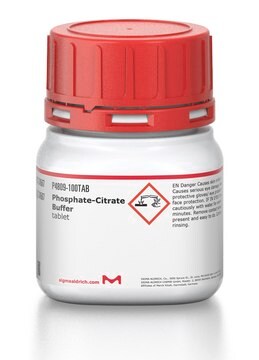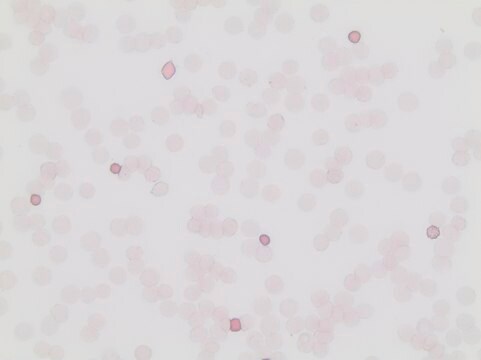C9999
Citrate Buffer, pH 6.0, 10×, Antigen Retriever
for immunohistochemistry
Sinonimo/i:
1,2,3-Propanetricarboxylic acid, 2-hydroxy-, mixt. with sodium hydroxide (Na(OH)) and sodium 2-hydroxy-1,2,3-propanetricarboxylate
Autenticatiper visualizzare i prezzi riservati alla tua organizzazione & contrattuali
About This Item
Codice UNSPSC:
12352107
NACRES:
NA.47
Prodotti consigliati
Livello qualitativo
Stato
liquid
pH
6.0
applicazioni
hematology
histology
Temperatura di conservazione
2-8°C
Applicazioni
Citrate Buffer, pH 6.0, 10×, Antigen Retriever has been used as a heat-induced antigen retriever on formalin-fixed paraffin-embedded (FFPE) tissue sections prior to application of antibodies or DNA fluorescent in situ hybridization. In immunohistochemistry (IHC), most commonly used fixatives such as formalin mask tissue antigens (cellular, membrane, and nuclear) by their intrinsic crosslinking. This masking results in poor or no staining in IHC. The use of Citrate buffer, pH 6.0, or other antigen retrieval solutions on FFPE tissue sections improves accessibility of antibodies to tissue antigens.
Nota sulla preparazione
Dilute the Citrate buffer, pH 6.0, 10x, Antigen Retriever 10-fold with water to prepare a 1x Working Solution, e.g., dilute 10 mL of 10x concentrate with 90 mL of water.
Stoccaggio e stabilità
Store the product at 2–8 °C. Do Not Freeze to prevent possible precipitation.
Altre note
Occasionally the buffer may contain a yellowish tinge. This is due to preservative and will not affect the function of the buffer.
Store the prepared 1′ Citrate buffer, pH 6.0, Working Solution at 2–8 °C.
Store the prepared 1′ Citrate buffer, pH 6.0, Working Solution at 2–8 °C.
Prodotti correlati
N° Catalogo
Descrizione
Determinazione del prezzo
Avvertenze
Warning
Indicazioni di pericolo
Consigli di prudenza
Classi di pericolo
Aquatic Chronic 3 - Skin Sens. 1
Codice della classe di stoccaggio
12 - Non Combustible Liquids
Classe di pericolosità dell'acqua (WGK)
WGK 2
Punto d’infiammabilità (°F)
Not applicable
Punto d’infiammabilità (°C)
Not applicable
Scegli una delle versioni più recenti:
Possiedi già questo prodotto?
I documenti relativi ai prodotti acquistati recentemente sono disponibili nell’Archivio dei documenti.
I clienti hanno visto anche
Joel L Coble et al.
Human molecular genetics, 26(16), 3212-3220 (2017-06-09)
Diverticulitis is a chronic disease of the colon in which diverticuli, or outpouching through the colonic wall, become inflamed. Although recent observations suggest that genetic factors may play a significant role in diverticulitis, few genes have yet been implicated in
Sumit Agarwal et al.
Translational oncology, 13(7), 100776-100776 (2020-05-19)
Pancreatic ductal adenocarcinoma (PDAC) is an aggressive cancer with an extremely poor prognosis. There is an urgent need to identify new therapeutic targets and also understand the mechanism of PDAC progression that leads to aggressiveness of the disease. To find
Jennifer A Francesconi et al.
Behavioural brain research, 382, 112467-112467 (2020-01-10)
Male and female C57BL/6 J mice were tested on the predator odor response task, where they needed to cross through a chamber of scented bedding to reach a sucrose reward. Following the behavioral testing, mouse brains were immunohistochemically labeled for expression
Talveen S Purba et al.
European journal of cell biology, 96(6), 632-641 (2017-04-18)
Human hair follicle (HF) growth and hair shaft formation require terminal differentiation-associated cell cycle arrest of highly proliferative matrix keratinocytes. However, the regulation of this complex event remains unknown. CIP/KIP family member proteins (p21CIP1, p27KIP1 and p57KIP2) regulate cell cycle
S R Shi et al.
The journal of histochemistry and cytochemistry : official journal of the Histochemistry Society, 43(2), 193-201 (1995-02-01)
Antigen retrieval (AR) incorporating high-temperature microwave (MW) heating of tissue sections before immunostaining is a revolutionary technique that can unmask the antigens in formalin-fixed tissue sections, thus making them available for immunohistochemical staining. Although high temperature is believed to be
Il team dei nostri ricercatori vanta grande esperienza in tutte le aree della ricerca quali Life Science, scienza dei materiali, sintesi chimica, cromatografia, discipline analitiche, ecc..
Contatta l'Assistenza Tecnica.










